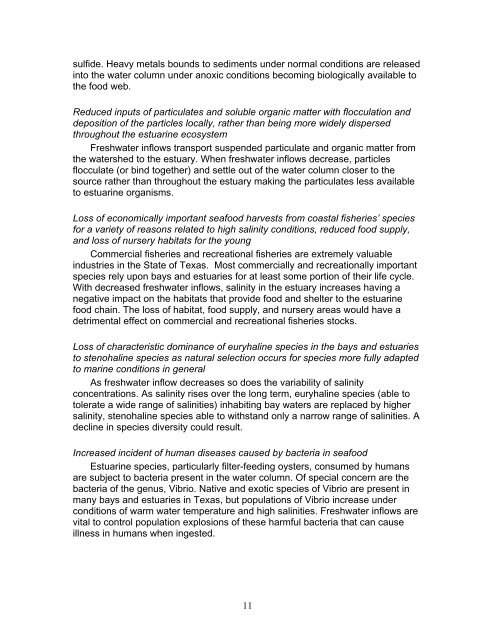The Economic Value of Water and Ecosystem Preservation
The Economic Value of Water and Ecosystem Preservation
The Economic Value of Water and Ecosystem Preservation
You also want an ePaper? Increase the reach of your titles
YUMPU automatically turns print PDFs into web optimized ePapers that Google loves.
sulfide. Heavy metals bounds to sediments under normal conditions are released<br />
into the water column under anoxic conditions becoming biologically available to<br />
the food web.<br />
Reduced inputs <strong>of</strong> particulates <strong>and</strong> soluble organic matter with flocculation <strong>and</strong><br />
deposition <strong>of</strong> the particles locally, rather than being more widely dispersed<br />
throughout the estuarine ecosystem<br />
Freshwater inflows transport suspended particulate <strong>and</strong> organic matter from<br />
the watershed to the estuary. When freshwater inflows decrease, particles<br />
flocculate (or bind together) <strong>and</strong> settle out <strong>of</strong> the water column closer to the<br />
source rather than throughout the estuary making the particulates less available<br />
to estuarine organisms.<br />
Loss <strong>of</strong> economically important seafood harvests from coastal fisheries’ species<br />
for a variety <strong>of</strong> reasons related to high salinity conditions, reduced food supply,<br />
<strong>and</strong> loss <strong>of</strong> nursery habitats for the young<br />
Commercial fisheries <strong>and</strong> recreational fisheries are extremely valuable<br />
industries in the State <strong>of</strong> Texas. Most commercially <strong>and</strong> recreationally important<br />
species rely upon bays <strong>and</strong> estuaries for at least some portion <strong>of</strong> their life cycle.<br />
With decreased freshwater inflows, salinity in the estuary increases having a<br />
negative impact on the habitats that provide food <strong>and</strong> shelter to the estuarine<br />
food chain. <strong>The</strong> loss <strong>of</strong> habitat, food supply, <strong>and</strong> nursery areas would have a<br />
detrimental effect on commercial <strong>and</strong> recreational fisheries stocks.<br />
Loss <strong>of</strong> characteristic dominance <strong>of</strong> euryhaline species in the bays <strong>and</strong> estuaries<br />
to stenohaline species as natural selection occurs for species more fully adapted<br />
to marine conditions in general<br />
As freshwater inflow decreases so does the variability <strong>of</strong> salinity<br />
concentrations. As salinity rises over the long term, euryhaline species (able to<br />
tolerate a wide range <strong>of</strong> salinities) inhabiting bay waters are replaced by higher<br />
salinity, stenohaline species able to withst<strong>and</strong> only a narrow range <strong>of</strong> salinities. A<br />
decline in species diversity could result.<br />
Increased incident <strong>of</strong> human diseases caused by bacteria in seafood<br />
Estuarine species, particularly filter-feeding oysters, consumed by humans<br />
are subject to bacteria present in the water column. Of special concern are the<br />
bacteria <strong>of</strong> the genus, Vibrio. Native <strong>and</strong> exotic species <strong>of</strong> Vibrio are present in<br />
many bays <strong>and</strong> estuaries in Texas, but populations <strong>of</strong> Vibrio increase under<br />
conditions <strong>of</strong> warm water temperature <strong>and</strong> high salinities. Freshwater inflows are<br />
vital to control population explosions <strong>of</strong> these harmful bacteria that can cause<br />
illness in humans when ingested.<br />
11
















